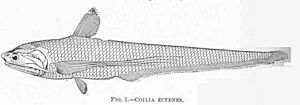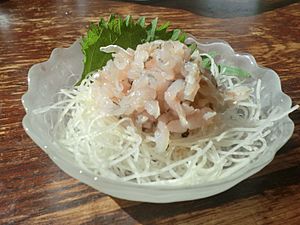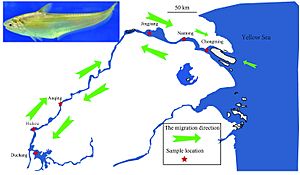Ungeo facts for kids
Quick facts for kids Ungeo |
|
|---|---|
 |
|
| Scientific classification | |
| Synonyms | |
|
Coilia ectenes Jordan and Seale, 1905 |
The Coilia nasus, also known as the Japanese grenadier anchovy or Chinese tapertail anchovy, is a type of fish. It belongs to the anchovy family, which are ray-finned fish. This fish can grow up to 41 centimeters (about 16 inches) long, which is quite large for an anchovy.
You can find Coilia nasus in different types of water: salty ocean water, fresh river water, and brackish water (a mix of salt and fresh water). They live at depths of up to 50 meters (about 164 feet). These fish are found in the northwest Pacific Ocean, from China's Guangdong province all the way to the west coast of the Korean peninsula and the Ariake Sound in southwestern Japan.
This fish is a popular food in Korea, China, and Japan. In China, it's one of the most expensive fish you can buy. The ones that swim from the sea to rivers are even more valuable. Because of this, fishing for Coilia nasus is a big business, especially in the Yellow Sea, East China Sea, and the Yangtze River.
Fish Migration and Life Cycle
Some groups of Coilia nasus are anadromous. This means they live in the ocean but swim up rivers to lay their eggs. Every spring, these fish travel up the Yangtze River in China. They finish growing their eggs there and then spawn (lay their eggs) in the middle and lower parts of the river. After spawning, the adult fish swim back to the sea.
Interestingly, other groups of Coilia nasus live their whole lives in freshwater lakes. They don't migrate to the sea at all. This makes the species a great example of "partial migration." This means some fish migrate, while others stay in one place. Scientists call this "migratory dimorphism" because there are two different migration patterns within the same species.
To understand why some fish migrate and others don't, scientists have studied their reference genome. A genome is like a complete instruction book for an organism. By looking at the genes of both the migrating and non-migrating fish, scientists can learn more about how they adapt to different environments and why they have these different life cycles.
See also
 In Spanish: Ungeo para niños
In Spanish: Ungeo para niños



